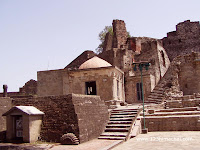Himachal Pradesh is the historical place. Every District in Himachal has a historical presence in the India. The Kangra Fort is the one in a list of historical places in Himachal. It is located 20 kilometers from the town of Dharamsala. It is on the outskirts of the town of Kangra. The fort was first mentioned in Alexander the Great's war records, referring to the 4th century BC.
There was a Royal family of Kangra “The Katoch Dynasty”. The Fort was built by this Royal family of Kangra, which traces its origins to the ancient Trigarta Kingdom, mentioned in the Mahabharata epic. It is one of the oldest and largest forts in the Himalayas. Probably, it is the oldest dated fort in India.
This fort was taken by the Mahmud of Ghazni in AD 1009. In 1337, it was captured by Muhammad bin Tughluq and again in 1351 by his successor, Firuz Shah Tughluq. It was conquered by the Mughal Emperor Jahangir who garrisoned it with his troops and appointed a Governor to keep the turbulent hill chiefs in check.
In the second half of 18th Century, following the decline of Mughal power, Raja Sansar Chand-II succeeded in recovering the ancient fort of his ancestors, in 1789. But by carrying his ambitions too far he came in conflict with the neighboring hill chiefs, the Gurkhas and finally with Maharaja of Punjab, “The Maharaja Ranjit Singh” to whom he was compelled to surrender Kangra Fort in 1809. It remained in the hands of the Sikhs till 1846 when it was made over to the British Government, along with the surrounding hills.
A statue claimed to be the earliest of Mahavira in Ambika Mata Temple at top of Kangra Fort.
A British garrison occupied the fort until it was heavily damaged in an earthquake in the year 1905. The entrance to the fort is through a small courtyard enclosed between two gates which were built during the Sikh period, as appears from an inscription over the entrance. From here a long and narrow passage leads up to the top of the fort, through the Ahani and Amiri Darwaza (gate), both attributed to Nawab Saif Ali Khan, the first Mughal Governor of Kangra. About 500 feet from the outer gate the passage turns round at a very sharp angle and passes through the Jehangiri Darwaza.
The Darsani Darwaza, which is now flanked by defaced statues of River Goddesses Ganga and Yamuna, gave access to a courtyard, along the south side of which stood the shrines Lakshmi-Narayana Sitala and Ambika Devi. In between these shrines is a passage that leads up to the palace. It is one of the most beautiful forts in India.














